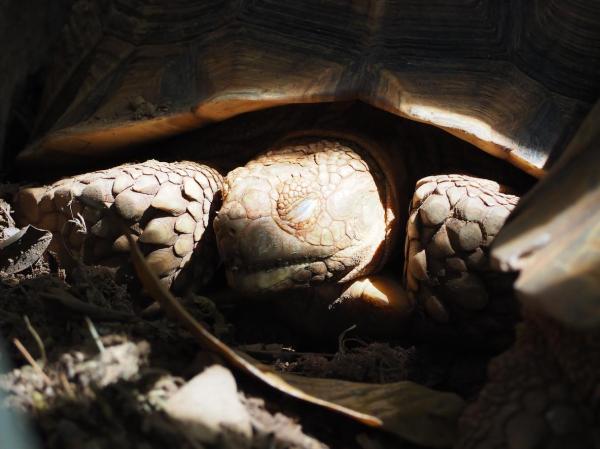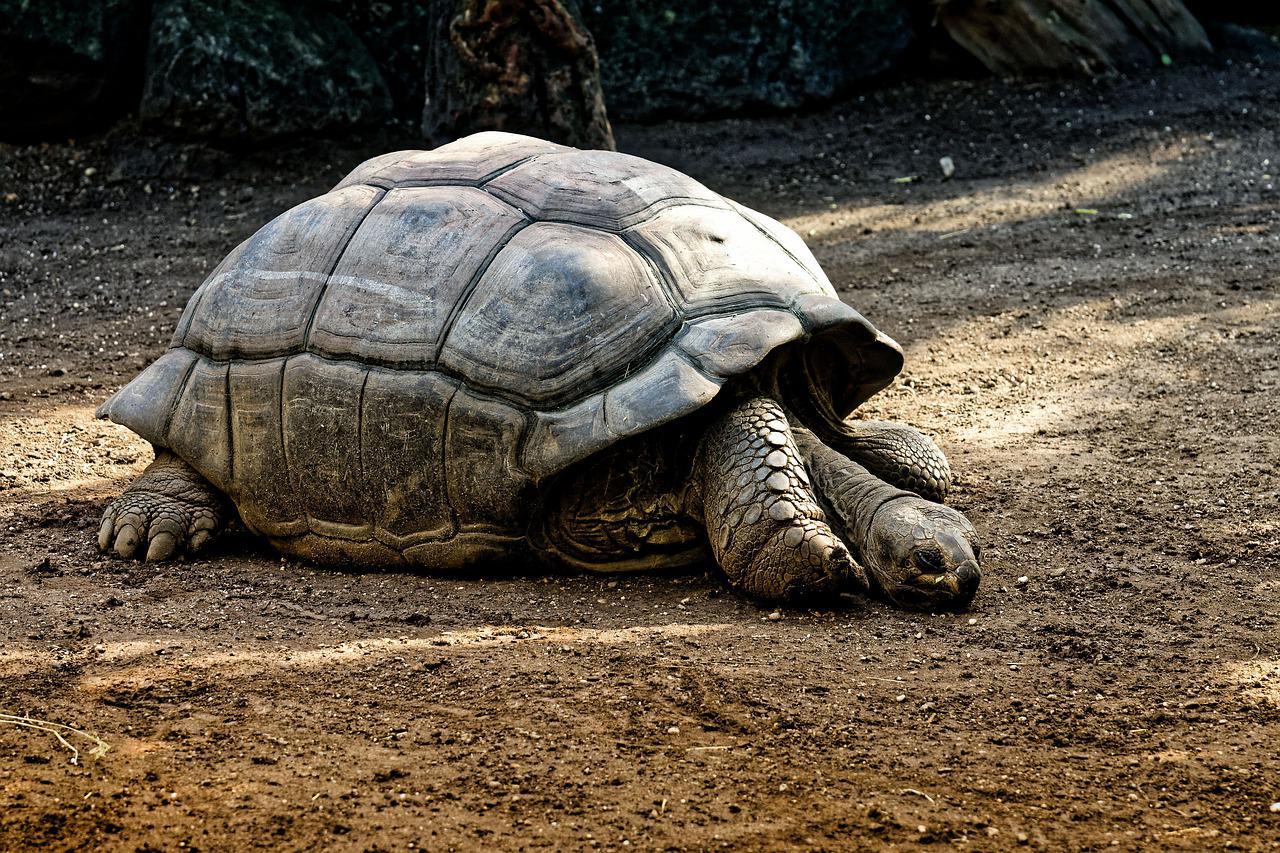My Turtle Isn't Moving - Why and What to Do


When we adopt a turtle, we should know what we are likely to experience. We won't be able to play fetch or run in the country. This doesn't mean turtles aren't incredibly rewarding pets, but they are slow movers. They can remain still for long periods, even if they are not asleep. However, they do move and they will need space to explore and carry out their turtle activities. If they stop moving for long periods, it may be time to become concerned.
At AnimalWised, we look at why my turtle is not moving. We look more closely at turtle behaviors to see how they can help us understand what to do if a turtle has stopped moving.
Why is my turtle not moving?
One of the main reasons a turtle isn't moving is for a very important purpose. They may have entered brumation. This is a process very similar to hibernation, except for reptiles like turtles. When turtles brumate, their metabolism slows down and they enter a deep sleep during which they do not move. Although they may look dead, they are simply resting. Some factors we need to take into account if our turtle is brumating include:
- Tortoises enter this state when the temperature is low, so one of the ways to check if your tortoise is hibernating is to check the temperature of their environment. We might be best able to do this by checking the water temperature. If it is below 10 ºC/50 ºF, it is very likely that they are in brumation. When tortoises are kept indoors, they normally do not experience a drop in temperature. However, it should not be ruled out that the tortoise enters this state when room temperatures are very low.
- When they brumate, turtles keep their limbs retracted into their shell, since they preserve muscle tone. If your tortoise isn't moving, but their limbs are out of their shell, or if their limbs come out of its shell when you pick them up, they are probably not brumating.
- An important aspect to consider is that not all species of turtle brumate, but this will depend on the climate of their natural habitat. Learn more with our article on whether all turtles hibernate.
Another option is that your turtle is simply sleeping or basking (bathing in the sun). You will know your tortoise is basking when they are in direct sunlight or their terrarium's light source. When tortoises are exposed to the sun, they normally stay relaxed with their limbs out of the shell.
If you are wondering why my turtle is not moving and you have ruled out the above causes, you should consider the possibility they suffering from a pathological disease. When a tortoise becomes ill, their energy and movement levels are greatly reduced. In the event that your turtle does not move, it is important you pay attention to the presence of other signs that may be indicators of illness. Some of these signs are:
- Stains or lesions on the shell or skin
- Shell discoloration
- Secretions from the oral cavity, nose, eyes or ears
- Respiratory signs such as cough or breath sounds
- Digestive signs such as diarrhea
Find out other signs of illness in tortoises with our article on whether a turtle's poop is healthy.
Likewise, it is important that you check if you are offering your turtle food and environmental conditions appropriate to its species, age and physiological state. A large part of the clinical problems in turtles usually derive from poor conditions in their environment or inadequate diet. The main factors you should consider are:
- Temperature and humidity: turtles are ectothermic and poikilothermic animals, meaning they require exposure to the sun or other sources of heat to regulate body temperature. These include the substrate or warm water currents. Maintaining body temperature in an adequate range determines the proper functioning of their immune system and multiple vital functions. It is essential you adapt the environmental temperature to the needs of your turtle. It is also important to maintain the humidity in the correct range to avoid the appearance of dermatological, renal and digestive problems.
- Substrate and environment: whether you keep your turtle outside or in a terrarium, you need to adapt the environment to be as close to their natural habitat as possible and maintain hygienic conditions.
- Photoperiod: it is important to respect the photoperiod of the turtle's place of origin, since prolonging it can be a source of stress for it.
- Food: turtles can be herbivorous, omnivorous or carnivorous, depending on their species. An adequate diet will be one that is similar to what the animal would have in its natural habitat.
Learn more about turtle brumation with our article on whether a turtle is hibernating or dead.
Why is my baby turtle not moving?
If your new companion has recently arrived at home, it is normal their behavior is somewhat abnormal and they may not move much. Turtles are animals that are easily stressed and frightened. A change of habitat can be truly stressful for them. In this case, you should provide the necessary time to adjust to their new home. Keep the terrarium away from loud noise, prevent other pets from approaching and handle them as little as possible.
As we have mentioned before, when a turtle remains motionless, they may be hibernating or brumating. Although the turtle may appear dead, brumation is a natural process that affects tortoises when temperatures drop. However, in young specimens (under 3 years old) brumation should not occur. They lack the necessary energy reserves to survive this process. If you have a baby turtle and you suspect that they may be brumating, go to your veterinarian to find out how to proceed.
As with adult turtles, if your baby turtle is not moving, it may be due to a disease. Pay attention to the presence of other clinical signs that may indicate such a disease in your turtle and go to your veterinarian so that you can find the cause of the problem. Learn more with our guide to the most common diseases in turtles.

What to do if my turtle does not move?
If your turtle is brumating, you should leave them alone. Brumation is a physiological and natural process that should not cause a healthy turtle any harm. If your tortoise has undergone surgery or suffered from an illness in the previous season, brumation should not be allowed. This is because their immune response may be hindered and the low temperatures could have serious consequences for their health.
Similarly, it is not recommended that young turtles carry out brumation. They do not have enough energy resources to survive this process. When you think that your turtle is going to go into brumation, it is important you consult your veterinarian to analyze whether or not it is appropriate for them.
If your turtle does not move, their eyes are closed and you have ruled out brumation, it is also important you go to your trusted veterinarian to determine what may be the cause of their condition. They will analyze the environmental conditions and the turtle's diet to assess whether poor sanitary management may be the cause.
The veterinarian will also carry out a complete examination of the turtle to look for signs that can guide the diagnosis. If the physical examination is not sufficient, additional tests (imaging tests, laboratory tests, etc.) will be carried out to reach a definitive diagnosis and establish the appropriate treatment.
The reasons why a turtle doesn't move and with their eyes closed can be both physiological and pathological. Discerning the specific cause will be essential to know whether we should act or not, and if necessary, how to proceed.
Learn more about how to look after turtles with our complete pet turtle care guide.
If you want to read similar articles to My Turtle Isn't Moving - Why and What to Do, we recommend you visit our Extra care category.
- Mitchell, M., & Tully, T. (2008). Chelonians. Manual of Exotic Pet Practice (207-249). SaundersElsevier.
- Soler, J., & Martinez, A. (2008). Management and feeding of tortoises and freshwater turtles in captivity. Center for the Recovery of Amphibians and Reptiles of Catalonia, 147, 33-41.
- Tracchia, A. C. (2018). Medicine in turtles and other reptiles. Maimonides University.






